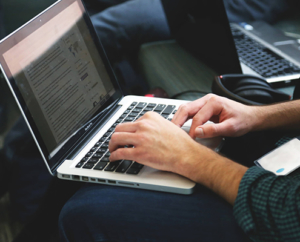Protecting Yourself from a Data Breach requires Two Step Authentication
Have you ever thought about how a data breach could affect you personally? What about your business? Either way, it can be devastating. Fortunately, there are ways that you can protect your personal or business data, and it’s easier than you think. Don’t assume that protecting yourself is impossible just because big corporations get hit with data breaches all of the time. There are things you can do to get protected.

- All of your important accounts should use two-factor authentication. This helps to eliminate the exposure of passwords. Once one of the bad guys gets access to your password, and that’s all they need to access your account, they are already in.
- When using two-factor authentication, you must first enter your password. However, you also have to do a second step. The website sends the owner of the account a unique code to their phone also known as a “one time password”. The only way to access the account, even if you put the password in, is to enter that code. The code changes each time. So, unless a hacker has your password AND your mobile phone, they can’t get into your account.
All of the major websites that we most commonly use have some type of two-factor authentication. They are spelled out, below:
The two-factor authentication that Facebook has is called “Login Approvals.” You can find this in the blue menu bar at the top right side of your screen. Click the arrow that you see, which opens a menu. Choose the Settings option, and look for a gold colored badge. You then see “Security,” which you should click. To the right of that, you should see Login Approvals and near that, a box that says “Require a security code.” Put a check mark there and then follow the instructions. The Facebook Code Generator might require a person to use the mobile application on their phone to get their code. Alternatively, Facebook sends a text.
Google also has two-factor authentication. To do this, go to Google.com/2step, and then look for the blue “get started’ button. You can find it on the upper right of the screen. Click this, and then follow the directions. You can also opt for a text or a phone call to get a code. This also sets you up for other Google services, including YouTube.
Twitter also has a form of two-factor authentication. It is called “Login Verification.” To use it, log in to Twitter and click on the gear icon at the top right of the screen. You should see “Security and Privacy.” Click that, and then look for “Login Verification” under the Security heading. You can then choose how to get your code and then follow the prompts.
PayPal
PayPal has a feature known as “Security Key.” To use this, look for the Security and Protection section on the upper right corner of the screen. You should see PayPal Security Key on the bottom left. Click the option to “Go to register your mobile phone.” On the following page, you can add your phone number. Then, you get a text from PayPal with your code.
Yahoo
Yahoo uses “Two-step Verification.” To use it, hover over your Yahoo avatar, which brings up a menu. Click on Account Settings and then on Account Info. Then, scroll until you see Sign-In and Security. There, you will see a link labeled “Set up your second sign-in verification.” Click that and enter your phone number. You should get a code via text.
Microsoft
The system that Microsoft has is called “Two-step Verification.” To use it, go to the website login.live.com. Look for the link on the left. It goes to Security Info. Click that link. On the right side, click Set Up Two-Step Verification, and then follow the prompts.
Apple
Apple also has something called “Two-Step Verification.” To use it, go to applied.apple.com. On the right is a blue box labeled Manage Your Apple ID. Hit that, and then use you Apple ID to log in. You should then see a link for Passwords and Security. You have to answer two questions to access the Security Settings area of the site. There, you should see another link labeled “Get Started.” Click that, and then enter your phone number. Wait for your code on your mobile phone, and then enter it.
LinkedIn also has “Two-Step Verification.” On the LinkedIn site, hover your mouse over your avatar and a drop-down menu should appear. Click on Privacy and Settings, and then click on Account. You should then see Security Settings, which you should also click. Finally, you should see the option to turn on Two-Step Verification for Sign-In. Turn that on to get your code.
These are only a few of the major sites that have two-step verification. Many others do, too, so always check to see if your accounts have this option. If they don’t, see if there is another option that you can use in addition to your password to log in. This could be an email or a telephone call, for instance. This will help to keep you safe.
Amazon
Amazon’s Two-Step Verification adds an additional layer of security to your account. Instead of simply entering your password, Two-Step Verification requires you to enter a unique security code in addition to your password during sign in.
Without setting up Two Step authentication for your most critical accounts, all a criminal needs is access to your username, which is often your email address and then access data breach files containing billions of passwords that are posted all over the web. Once they search your username/email for the associated password, they are in.
Two factor locks them out.
Robert Siciliano personal security and identity theft expert and speaker is the author of Identity Theft Privacy: Security Protection and Fraud Prevention: Your Guide to Protecting Yourself from Identity Theft and Computer Fraud. See him knock’em dead in this Security Awareness Training video.

 Most of us are taught to not hurt other people. We teach our children to have manners and to be kind to others. This is a process known as “civilized conditioning,” and it allows us to live in a civilized society.
Most of us are taught to not hurt other people. We teach our children to have manners and to be kind to others. This is a process known as “civilized conditioning,” and it allows us to live in a civilized society.
























